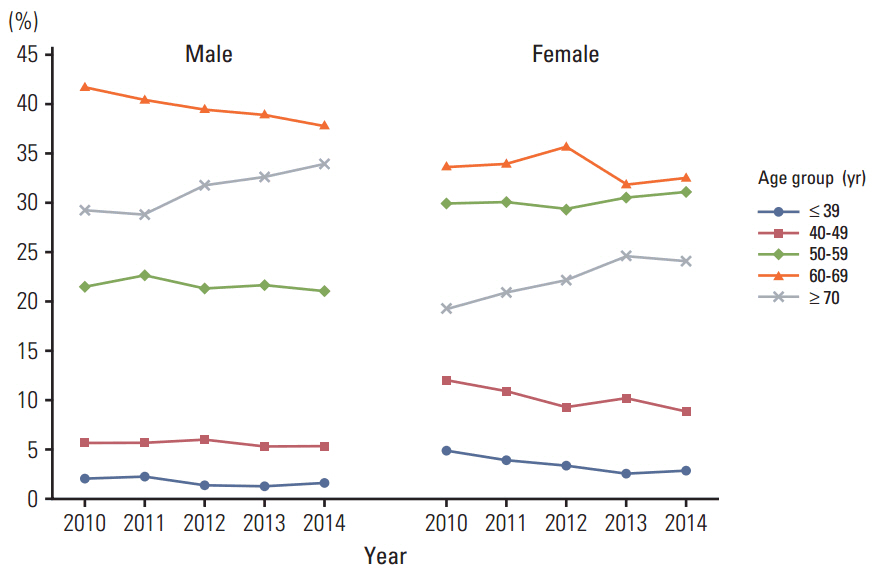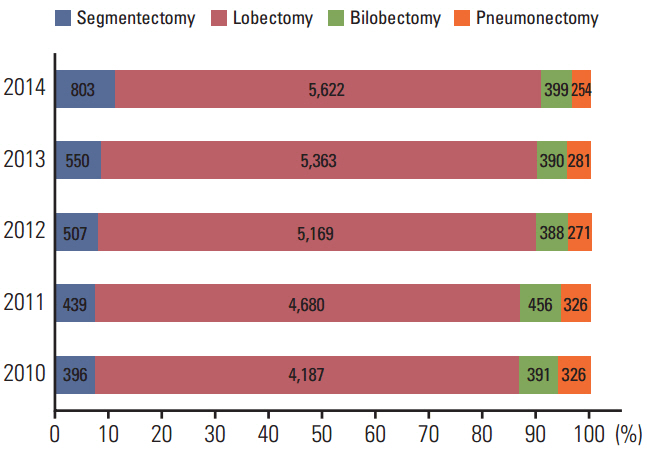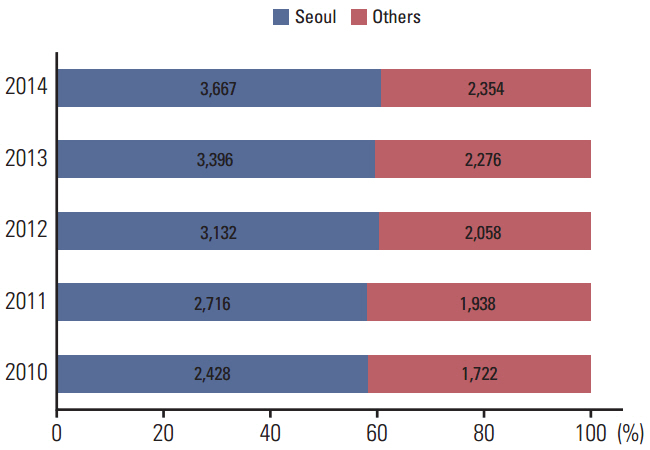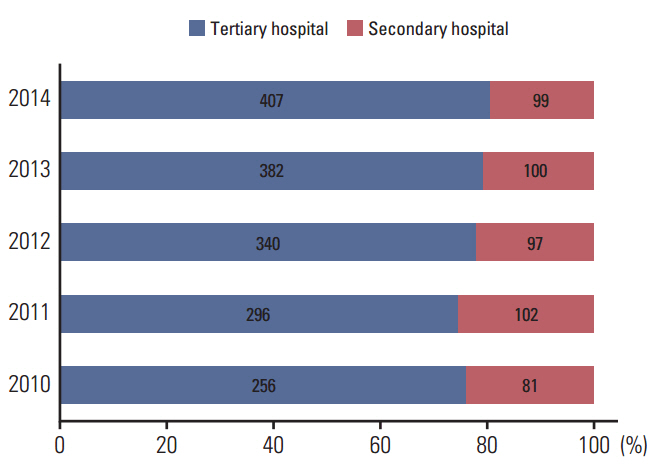Cancer Res Treat.
2017 Apr;49(2):330-337. 10.4143/crt.2016.196.
Current Trends of Lung Cancer Surgery and Demographic and Social Factors Related to Changes in the Trends of Lung Cancer Surgery: An Analysis of the National Database from 2010 to 2014
- Affiliations
-
- 1Department of Thoracic and Cardiovascular Surgery, Seoul National University Hospital, Seoul National University College of Medicine, Seoul, Korea. ikpark@snu.ac.kr
- KMID: 2378105
- DOI: http://doi.org/10.4143/crt.2016.196
Abstract
- PURPOSE
We investigated current trends in lung cancer surgery and identified demographic and social factors related to changes in these trends.
MATERIALS AND METHODS
We estimated the incidence of lung cancer surgery using a procedure code-based approach provided by the Health Insurance Review and Assessment Service (http://opendata.hira.or.kr). The population data were obtained every year from 2010 to 2014 from the Korean Statistical Information Service (http://kosis.kr/). The annual percent change (APC) and statistical significance were calculated using the Joinpoint software.
RESULTS
From January 2010 to December 2014, 25,687 patients underwent 25,921 lung cancer surgeries, which increased by 45.1% from 2010 to 2014. The crude incidence rate of lung cancer surgery in each year increased significantly (APC, 9.5; p < 0.05). The male-to-female ratio decreased from 2.1 to 1.6 (APC, −6.3; p < 0.05). The incidence increased in the age group of ≥ 70 years for both sexes (male: APC, 3.7; p < 0.05; female: APC, 5.96; p < 0.05). Furthermore, the proportion of female patients aged ≥ 65 years increased (APC, 7.2; p < 0.05), while that of male patients aged < 65 years decreased (APC, −3.9; p < 0.05). The proportions of segmentectomies (APC, 17.8; p < 0.05) and lobectomies (APC, 7.5; p < 0.05) increased, while the proportion of pneumonectomies decreased (APC, −6.3; p < 0.05). Finally, the proportion of patients undergoing surgery in Seoul increased (APC, 1.1; p < 0.05), while the proportion in other areas decreased (APC, −1.5; p < 0.05).
CONCLUSION
An increase in the use of lung cancer surgery in elderly patients and female patients, and a decrease in the proportion of patients requiring extensive pulmonary resection were identified. Furthermore, centralization of lung cancer surgery was noted.
Keyword
MeSH Terms
Figure
Cited by 2 articles
-
Higher Age Puts Lung Cancer Patients at Risk for Not Receiving Anti-cancer Treatment
Won-Il Choi, Jiah Choi, Mi-Ae Kim, Gyumin Lee, Jihyeon Jeong, Choong Won Lee
Cancer Res Treat. 2019;51(3):1241-1248. doi: 10.4143/crt.2018.513.Pulmonary Metastasectomy in Colorectal Cancer: A Population-Based Retrospective Cohort Study Using the Korean National Health Insurance Database
Woo Sik Yu, Mi Kyung Bae, Jung Kyu Choi, Young Ki Hong, In Kyu Park
Cancer Res Treat. 2021;53(4):1104-1112. doi: 10.4143/crt.2020.1213.
Reference
-
References
1. Jung KW, Won YJ, Kong HJ, Oh CM, Cho H, Lee DH, et al. Cancer statistics in Korea: incidence, mortality, survival, and prevalence in 2012. Cancer Res Treat. 2015; 47:127–41.
Article2. Ferlay J, Soerjomataram I, Dikshit R, Eser S, Mathers C, Rebelo M, et al. Cancer incidence and mortality worldwide: sources, methods and major patterns in GLOBOCAN 2012. Int J Cancer. 2015; 136:E359–86.
Article3. OECD.stat [Internet]. Paris: Organisation for Economic Co-operation and Development;2015. [cited 2015 Dec 9]. Available from: http://stats.oecd.org/.4. The Korea Central Cancer Registry; National Cancer Center. Annual report of cancer statistics in Korea in 2012 [Internet]. Goyang: National Cancer Information Center;2014. [cited 2015 Oct 15]. Available from: http://www.cancer.go.kr.5. Jung KW, Won YJ, Oh CM, Kong HJ, Cho H, Lee DH, et al. Prediction of cancer incidence and mortality in Korea, 2015. Cancer Res Treat. 2015; 47:142–8.
Article6. Dillman RO, McClure SE. Steadily improving survival in lung cancer. Clin Lung Cancer. 2014; 15:331–7.
Article7. Siegel RL, Miller KD, Jemal A. Cancer statistics, 2015. CA Cancer J Clin. 2015; 65:5–29.
Article8. The Korea Central Cancer Registry, National Cancer Center. Annual report of cancer statistics in Korea in 2011 [Internet]. Goyang: National Cancer Information Center; 2013 [cited 2015 Oct 15]. Available from: http://www.cancer.go.kr.9. The Korea Central Cancer Registry, National Cancer Center. Annual report of cancer statistics in Korea in 2010 [Internet]. Goyang: National Cancer Information Center; 2012 [cited 2015 Oct 15]. Available from: http://www.cancer.go.kr.10. National Lung Screening Trial Research Team, Aberle DR, Adams AM, Berg CD, Black WC, Clapp JD, et al. Reduced lung-cancer mortality with low-dose computed tomographic screening. N Engl J Med. 2011; 365:395–409.
Article11. Korea Centers for Disease Control and Prevention. Korea Health Statistic 2013: Korea National Health and Nutrition Examination Survery (KNHANES VI-1) [Internet]. Cheongju: Centers for Disease Control and Prevention;2013. [cited 2015 Oct 15]. Available from: http://knhanes.cdc.go.kr.12. Population Division, Department of Economic and Social Affairs, United Nations. World population ageing 2013 [Internet]. New York: United Nations;2013. [cited 2015 Dec 2]. Available from: http://www.un.org/.13. Kwon S. Thirty years of national health insurance in South Korea: lessons for achieving universal health care coverage. Health Policy Plan. 2009; 24:63–71.
Article14. Morgant MC, Pages PB, Orsini B, Falcoz PE, Thomas PA, Barthes FL, et al. Time trends in surgery for lung cancer in France from 2005 to 2012: a nationwide study. Eur Respir J. 2015; 46:1131–9.
Article15. Strand TE, Bartnes K, Rostad H. National trends in lung cancer surgery. Eur J Cardiothorac Surg. 2012; 42:355–8.
Article16. Riaz SP, Linklater KM, Page R, Peake MD, Moller H, Luchtenborg M. Recent trends in resection rates among non-small cell lung cancer patients in England. Thorax. 2012; 67:811–4.
Article17. Memtsoudis SG, Besculides MC, Zellos L, Patil N, Rogers SO. Trends in lung surgery: United States 1988 to 2002. Chest. 2006; 130:1462–70.18. Center for Cancer Control and Information Services; National Cancer Center. Cancer Statistics in Japan [Internet]. Tokyo: Center for Cancer Control and Information Services, National Cancer Center;2014. [cited 2015 Dec 2]. Available from: http://ganjoho.jp/.19. Kowdley GC, Merchant N, Richardson JP, Somerville J, Gorospe M, Cunningham SC. Cancer surgery in the elderly. ScientificWorldJournal. 2012; 2012:303852.
Article20. Manceau G, Karoui M, Werner A, Mortensen NJ, Hannoun L. Comparative outcomes of rectal cancer surgery between elderly and non-elderly patients: a systematic review. Lancet Oncol. 2012; 13:e525–36.
Article21. Milisavljevic D, Stankovic M, Zivic M, Stankovic P. Head and neck cancer surgery in elderly: complications and survival rate. Coll Antropol. 2012; 36 Suppl 2:13–7.22. McMahon M, Barbiere JM, Greenberg DC, Wright KA, Lyratzopoulos G. Population-based trends in use of surgery for non-small cell lung cancer in a UK region, 1995-2006. Thorax. 2011; 66:453–5.
Article23. Peake MD, Thompson S, Lowe D, Pearson MG; Participating Centres. Ageism in the management of lung cancer. Age Ageing. 2003; 32:171–7.
Article24. Population Division, Department of Economic and Social Affairs, United Nation. World population ageing 1950-2050 [Internet]. New York: United Nations;2001. [cited 2015 Dec 2]. Available from: http://www.un.org/.25. Orimo H, Ito H, Suzuki T, Araki A, Hosoi T, Sawabe M. Reviewing the definition of "elderly". Geriatr Gerontol Int. 2006; 6:149–58.
Article26. Owonikoko TK, Ragin CC, Belani CP, Oton AB, Gooding WE, Taioli E, et al. Lung cancer in elderly patients: an analysis of the surveillance, epidemiology, and end results database. J Clin Oncol. 2007; 25:5570–7.
Article27. Jie C, Wever AM, Huysmans HA, Franken HC, Wever-Hess J, Hermans J. Time trends and survival in patients presented for surgery with non-small-cell lung cancer 1969-1985. Eur J Cardiothorac Surg. 1990; 4:653–7.
Article28. Horeweg N, van der Aalst CM, Thunnissen E, Nackaerts K, Weenink C, Groen HJ. Characteristics of lung cancers detected by computer tomography screening in the randomized NELSON trial. Am J Respir Crit Care Med. 2013; 187:848–54.
Article29. Crestanello JA, Allen MS, Jett JR, Cassivi SD, Nichols FC 3rd, Swensen SJ, et al. Thoracic surgical operations in patients enrolled in a computed tomographic screening trial. J Thorac Cardiovasc Surg. 2004; 128:254–9.
Article30. International Early Lung Cancer Action Program Investigators, Henschke CI, Yankelevitz DF, Libby DM, Pasmantier MW, Smith JP, et al. Survival of patients with stage I lung cancer detected on CT screening. N Engl J Med. 2006; 355:1763–71.
Article
- Full Text Links
- Actions
-
Cited
- CITED
-
- Close
- Share
- Similar articles
-
- Current Trends in Early Diagnosis and Treatment of Lung Cancer
- Current Status of Lung Cancer and Surgery Based on Studies Using a Nationwide Database
- Epidemiologic study of epidural analgesia for lung cancer surgery from 2011 to 2018 in South Korea: a National Health Insurance Database cohort study
- Temporal Changes of Lung Cancer Mortality in Korea
- Screening for Lung Cancer





